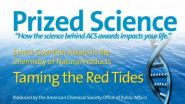(Press-News.org) Athens, Ga. – University of Georgia researchers have developed a technique that can diagnose a common type of pneumonia within minutes, potentially replacing existing tests that can take several days for results.
The researchers, whose findings are detailed online in the journal PLoS ONE, detected Mycoplasma pneumoniae, which causes atypical or "walking pneumonia," in true clinical samples with over 97 percent accuracy using a recently-developed nanotechnology-based platform.
"If you can make a positive identification from a 10-minute test, then appropriate antibiotics can be prescribed, limiting both the consequences in that patient and the likelihood that it will spread to others," said lead-author Duncan Krause, a professor in the department of microbiology in the UGA Franklin College of Arts and Sciences.
Krause and his colleagues built upon an existing technology called surface-enhanced Raman spectroscopy, which works by detecting spectral signatures of a near-infrared laser as it scatters off a biological specimen. They were able to enhance the Raman signal by using silver nanorod arrays to detect the tiny bacteria in throat swab specimens.
Krause, who also directs the interdisciplinary UGA Faculty of Infectious Diseases, compared the nanorod array developed by collaborator Yiping Zhao, director of the UGA Nanoscale Science and Engineering Center, to a brush with densely packed bristles, where each of the tiny silver rods extends out at a specific angle. The sample, such as bacteria from a throat swab, penetrates among the bristles, where the spectral signature produced by the laser is amplified and then analyzed by a computer program.
Krause noted that infections due to M. pneumoniae are very common yet difficult to diagnose. The bacterium is a major cause of respiratory disease in humans and the leading cause of pneumonia in older children and young adults.
"Walking pneumonia feels like a bad chest cold that will not go away," he explained. "It can persist for weeks and even months and can cause permanent damage to the lungs if not diagnosed promptly. A delay in diagnosis extends the likelihood for complications as well as continued transmission of the infection to others."
Krause said the device can be reduced to a size that could fit in a briefcase, although their testing is currently done only in a laboratory setting. "Our hope is that when we begin to explore the capabilities of this technology, it can be applied in point-of-care testing," he added. "Then the impact becomes truly significant."
Krause hopes the combined efforts of the research specialists in nanotechnology and infectious disease will eventually be able to determine if the technique is effective in detecting other pathogens in clinical samples. "We need to do a thorough job with mycoplasmas first," said Krause. "Then we can go to other clinical samples and ask the same questions with other infectious agents."
INFORMATION:
Funding for the research was provided by the U.S. Army Research Laboratory, the National Science Foundation and the Georgia Research Alliance.
For more information on UGA department of microbiology, see www.uga.edu/mib/. For further information on UGA Nanoscale Science and Engineering Center, see http://nano.uga.edu/.
UGA researchers develop rapid diagnostic test for common type of pneumonia
2010-12-16
ELSE PRESS RELEASES FROM THIS DATE:
A positive mood allows your brain to think more creatively
2010-12-16
People who watch funny videos on the internet at work aren't necessarily wasting time. They may be taking advantage of the latest psychological science—putting themselves in a good mood so they can think more creatively.
"Generally, positive mood has been found to enhance creative problem solving and flexible yet careful thinking," says Ruby Nadler, a graduate student at the University of Western Ontario. She and colleagues Rahel Rabi and John Paul Minda carried out a new study published in Psychological Science, a journal of the Association for Psychological Science. ...
Protein disables p53, drives breast cells toward cancer transition
2010-12-16
HOUSTON - The recently identified TRIM24 protein plays an active role in pushing normal breast cells into rapid cell proliferation and, potentially, into breast cancer.
Reporting in the journal Nature, a team led by researchers at The University of Texas MD Anderson Cancer Center found that TRIM24 (tripartite motif-containing 24) pushes estrogen-responsive genes toward active expression. This expression, in turn, sets the stage for malignant transformation of breast cells. TRIM24 functions by reading a specific code, or signature, present at estrogen-regulated genes and ...
Elevated zinc concentrations in Colorado waterway likely a result of climate change
2010-12-16
Rising concentrations of zinc in a waterway on Colorado's Western Slope may be the result of climate change that is affecting the timing of annual snowmelt, says a new study led by the University of Colorado at Boulder.
The study focused on the Snake River watershed just west of the Continental Divide near Keystone, Colo., where CU-Boulder researchers have observed a four-fold increase in dissolved zinc over the last 30 years during the lowest water flow months, said Caitlin Crouch. Crouch, a master's degree student who led the study, said the high levels of zinc affect ...
Study improves understanding of method for creating multi-metal nanoparticles
2010-12-16
A new study from researchers at North Carolina State University sheds light on how a technique that is commonly used for making single-metal nanoparticles can be extended to create nanoparticles consisting of two metals – and that have tunable properties. The study also provides insight into the optical properties of some of these nanoparticles.
Tuning the optical properties of nanoparticles is of interest for applications such as security technology, and for use in making chemical reactions more efficient – which has multiple industrial and environmental applications. ...
New American Chemical Society Prized Science video on 'red tide' shellfish poisoning
2010-12-16
WASHINGTON, Dec. 15, 2010 — The quest to cure a terrible form of food poisoning caused by population explosions of algae that stain the water red and produce a potent toxin is the topic of a new episode in the American Chemical Society (ACS) Prized Science video series.
Entitled "Taming the Red Tides," the high-definition video, released today, focuses on Michael Crimmins, Ph.D., winner of the 2010 Ernest Guenther Award in the Chemistry of Natural Products. Crimmins, a chemist at the University of North Carolina in Chapel Hill, studies brevetoxin A, a poison produced ...
Study supports gluten-free diet in potential celiac disease patients
2010-12-16
Findings from a new study of 141 adults add to an ongoing medical debate over which patients with symptoms of celiac disease should go on a gluten-free diet. Published in ACS' Journal of Proteome Research, the study concludes that people currently diagnosed as "potential" celiac disease patients and not advised to follow a gluten-free diet may not be "potential" patients at all. Rather, the scientists found that these patients have the same distinctive metabolic fingerprint as patients with full-blown disease who do benefit from gluten-free diets.
In the study, Ivano ...
Does fluoride really fight cavities by 'the skin of the teeth?'
2010-12-16
In a study that the authors describe as lending credence to the idiom, "by the skin of your teeth," scientists are reporting that the protective shield fluoride forms on teeth is up to 100 times thinner than previously believed. It raises questions about how this renowned cavity-fighter really works and could lead to better ways of protecting teeth from decay, the scientists suggest. Their study appears in ACS' journal Langmuir.
Frank Müller and colleagues point out that tooth decay is a major public health problem worldwide. In the United States alone, consumers spend ...
Toxic toy crisis requires fresh solutions
2010-12-16
Manufacturer recalls of toys, promotional drinking glasses, and other children's products constitute an ongoing "toxic toys crisis" that requires banning potentially harmful ingredients in these products and other changes in policy and practices. That's the conclusion of a new analysis in ACS' journal Environmental Science & Technology.
Monica Becker, Sally Edwards and Rachel Massey note that in June the United States government recalled 12 million promotional drinking glasses sold at a fast-food restaurant chain because the painted coating contained cadmium, a toxic ...
Preteen conduct problems leads to teenage serious violence and delinquency
2010-12-16
Montreal, December 15, 2010 – Conduct disorders in preteens are predictive of eventual teenage serious violent and delinquent behavior, according to a new study from the Université de Montréal. The findings, published in this month's issue of Journal of Child Psychology and Psychiatry, have implications for concerned parents.
Preteens who steal, destroy property, fight and bully are six times as likely to sell illicit drugs, nine times as likely to join a gang, 11 times as likely to carry a weapon and eight times as likely to be arrested as a future teenager, according ...
Cilantro ingredient can remove foul odor of holiday chitlins
2010-12-16
With chitlins about to make their annual appearance on Christmas and New Year's Day menus, scientists have good news for millions of people who love that delicacy of down-home southern cooking, but hate the smell. They are reporting the first identification of an ingredient in cilantro that quashes the notoriously foul odor of chitlins — a smell known to drive people from the house when chitlins are cooking. Their report appears in ACS' Journal of Agricultural and Food Chemistry.
Yasuyoshi Hayata and colleagues note that chitlins — hog large intestines — are infamous ...


